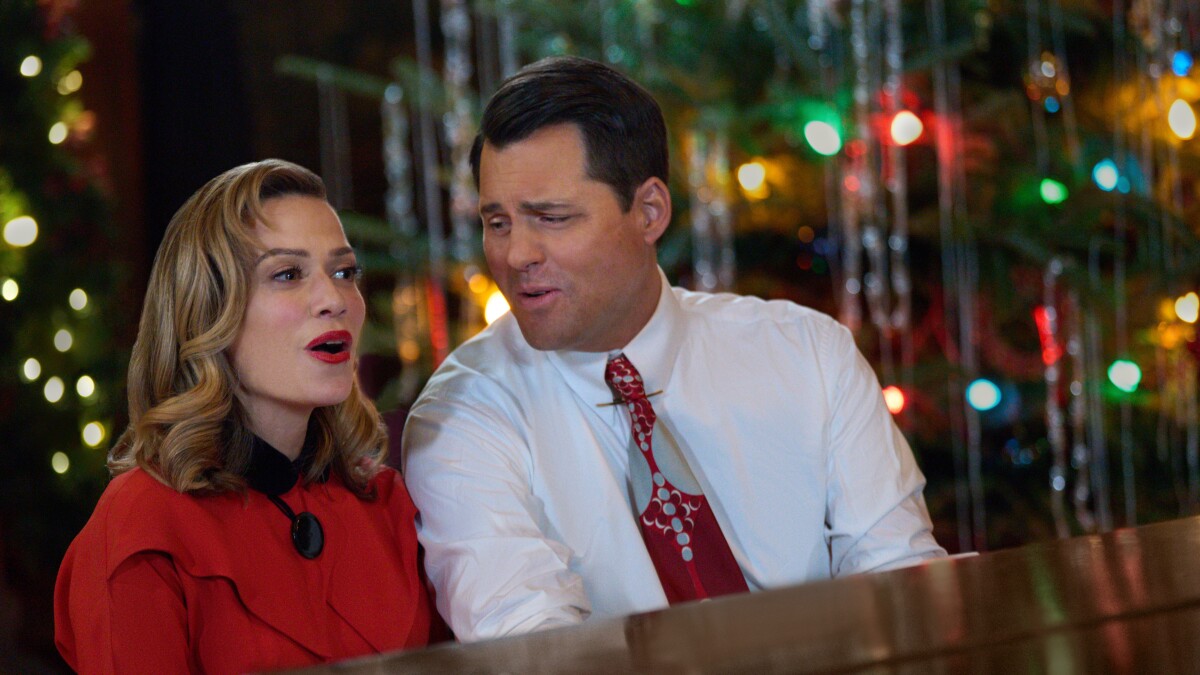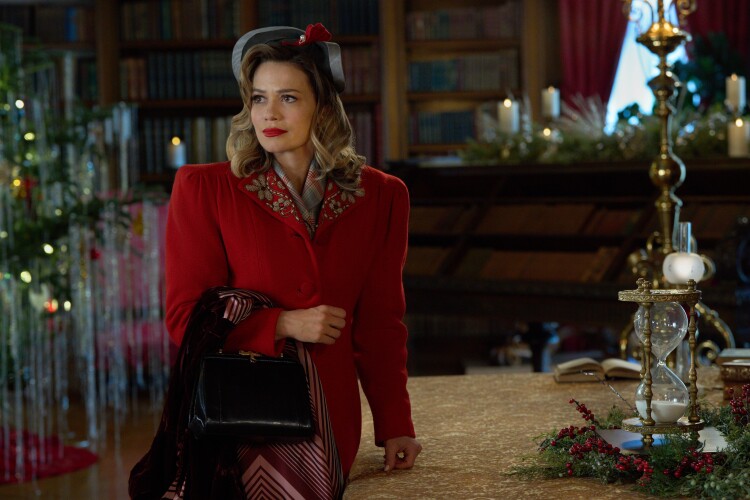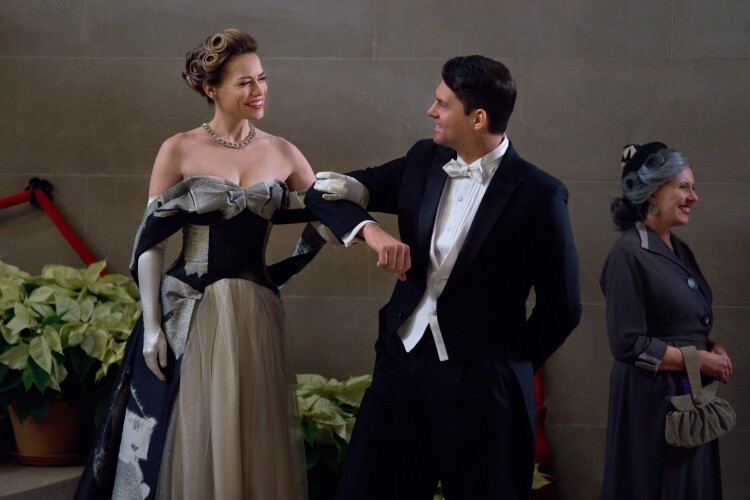Starring Bethany Joy Lenz and Kristoffer Polaha
***SPOILER ALERT***
Lucy (Lenz) has written a screenplay for the remake of a Hollywood Christmas classic, His Merry Wife!, about an angel sent to earth to unite two people, one of whom is the angel’s wife. Lucy’s boss dislikes her realistic ending, which doesn’t match the original’s happy one. He sends her to Biltmore House, where the original was filmed, to find inspiration to rewrite a cheerier ending. While she’s there, a magical hourglass in the library transports Lucy to the set of His Merry Wife! in 1947, where she meets Jack (Polaha). He’s the movie’s handsome star (he plays the angel), and he died in 1948. Everyone wonders why Lucy’s on set, so she pretends she was sent by the studio head to keep an eye on the filming. But in truth, Jack told her about rumors of a more somber ending, and she’s eager to know more. When she accidentally breaks the hourglass, she worries she’ll be stuck in 1947 forever unless she can get it fixed. But soon she and Jack fall head over heels in love, complicating everything, for Lucy’s return to the present day is inevitable.
PROS
This movie was directed by John Putch, director of A Holiday Spectacular, one of 2022’s most acclaimed Hallmark movies.
Romance! It was easy to fall under this film’s spell, and I felt as if I was being whisked away on a magic carpet ride. Lenz was lovely and glamorous, and Polaha dapper and debonair. They generated undeniable chemistry in both playful and serious moments as Lucy and Jack. Their “Jingle Bells” duet at the piano was a sheer delight, with both actors livening up the old tune with a touch of ’40s-style swing. At the Christmas party, Lucy and Jack shared a romantic dance and a kiss and he gave her his watch, confessing that he felt as if he’d always been meant to know her. Yes, there was a powerful sense of romantic destiny in this movie; Lucy and Jack were simply meant to be. Lucy then broke down in tears, saying “This isn’t real.” Of course, she knew in her heart that it was real; the catch was what to do about love when you and your sweetheart come from different eras. When she fled both Jack and the angry studio head determined to find her, Jack caught up to her. He called out wistfully, “Lucy, I’m glad that you came into my life, even if it was only for a little while.” What a heartbreaking moment.

Lucy and Jack’s ending. A year later, they were filming the remake—which retained the original movie’s happy ending—at the Biltmore. In the library, Lucy considered flipping the hourglass but decided not to, then said goodbye to Jack. A more predictable movie would have made this the moment she reunited with Jack by returning to 1947. But no—Jack came to her, mysteriously arriving without the aid of the hourglass. He hadn’t really died in 1948 (the studio fabricated this), and he’d given up everything—fame and fortune, his career—to be with her. If this didn’t leave you speechless and teary-eyed, I don’t know what would.
The other players. Though all the actors were terrific, a few stood out. The couple featured in the original movie, diva-like Ava and suave-looking Claude, were played perfectly by Annabelle Borke and Colton Little. Claude secretly wanted to oust Ava, a reminder that backstabbing sometimes played out behind the scenes of the glossiest, most picture-perfect Hollywood films. Jonathan Frakes made a dignified Winston, the Biltmore employee who conducted tours and was the caretaker of the magical hourglass. And A.K. Benninghofen added a fun note as Margaret, a Southern woman on the Biltmore tour and a His Merry Wife! superfan who looked out for Lucy. Be sure to watch for Rachel Boston and Wes Brown’s cameo appearance.
A nifty time travel device. I loved the idea of an hourglass that triggered time travel. It permitted Lucy to remain in the past only briefly, until the sand ran out; then she was whisked back to the present. Breaking the hourglass trapped her in 1947 until it could be repaired and she found it. But it was to be sent to the Smithsonian, so she had to get ahold of it before that happened. The hourglass added a sense of urgency. Right at the end, it was shown flipped on its side, the sand stationary—as if time was standing still for Lucy and Jack, who, no matter what, would always be together.
A homage to Golden Age Hollywood movies. Fans of old Hollywood will enjoy A Biltmore Christmas. The black-and-white clips from His Merry Wife! heightened the nostalgic feel, and the movie included references to Hollywood stars, including Polaha’s spot-on imitation of Jimmy Stewart. I also loved that the filmmakers included Judy Garland’s rendition of the sentimental “Have Yourself a Merry Little Christmas” from Meet Me in St. Louis.

A feast for the senses. It was a stroke of genius to film a movie at Biltmore House in North Carolina. It’s America’s biggest mansion and was completed in 1895 for George Washington Vanderbilt II, a wealthy art collector. Biltmore itself was a big part of this movie’s allure. The French château-style estate, with its vast grounds and sumptuous furnishings, was breathtaking. This movie also satisfied the senses with its attention to 1940s style. The costumes looked authentic, with the signature padded shoulders of the period. Jack’s suits had the generous cut you’d expect to see, and Lucy’s form-fitting jackets and coats also nicely evoked the era. Her little hats were adorably quaint. And that elegant strapless evening gown! Not to be overlooked was the lively big band-style musical score, which also plunged me into the 1940s.
CONS
None.
My grade for A Biltmore Christmas: A+!
Caroline Kaiser is a professional book editor who specializes in fiction and memoirs, and she’s been guiding writers toward publication since 2007. Caroline is also the author of two ghostly mystery novels, Virginia’s Ghost and The Spirits of South Drive. Before she embarked on an editing and writing career, she spent many years working in a Toronto auction house as an antiques appraiser. Apart from curling up on the couch and drinking tea as she watches Hallmark movies, Caroline enjoys baking and exploring London, Ontario, the picturesque city she now calls home. Her website is www.carolinekaisereditor.com.







